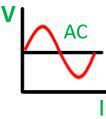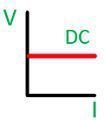| Definition | The closed path for magnetic flux is called a magnetic circuit. | The closed path for electric current is called an electric circuit. |
| Relation Between Flux and Current | Flux = MMF/reluctance | Current = emf/ resistance |
| Units | Flux φ is measured in weber (wb) | Current I is measured in amperes |
| MMF and EMF | Magnetomotive force is the driving force and is measured in Ampere turns (AT)
Mmf =ʃ H.dl | Electromotive force is the driving force and measured in volts (V)
Emf = ʃ E.dl |
| Reluctance and Resistance | Reluctance opposes the flow of magnetic flux S = l/aµ and measured in (AT/wb) | Resistance opposes the flow of current
R = ρ. l/a and measured in (Ώ)
|
| The relation between Permeance and Conduction | Permeance = 1/reluctance | Conduction = 1/ resistance |
| Analogy | Permeability | Conductivity |
| Analogy | Reluctivity | Resistivity |
| Density | Flux density B = φ/a (wb/m2) | Current density J = I/a (A/m2) |
| Intensity | Magnetic intensity H = NI/l | Electric density E = V/d |
| Drops | Mmf drop = φS | Voltage drop = IR |
| Flux and Electrons | In a magnetic circuit, molecular poles are aligned. The flux does not flow but sets up in the magnetic circuit. | In electric circuit electric current flows in the form of electrons. |
| Examples | For magnetic flux, there is no perfect insulator. It can set up even in non-magnetic materials like air, rubber, glass, etc. | For electric circuits, there are a large number of perfect insulators like glass, air, rubber, PVC, and synthetic resin which do not allow it to flow through them. |
| Variation of Reluctance and Resistance | The reluctance (S) of a magnetic circuit is not constant rather it varies with the value of B. | The resistance (R) of an electric circuit is almost constant as its value depends upon the value of ρ. The value of ρ and R can change slightly if the change in temperature takes place |
| The energy in the circuit | Once the magnetic flux sets up in a magnetic circuit, no energy is expanded. Only a small amount of energy is required at the initial stage to creating flux in the circuit. | Energy is expanding continuously, as long as the current flows through the electrical circuit.
This energy is dissipated in the form of heat.
|
| Applicable Laws | Kirchhoff flux and MMF law is followed | Kirchhoff voltage and the current law is followed. (KVL and KCL) |
| Magnetic and Electric lines | Magnetic lines of flux start from the North pole and end at the South pole. | Electric lines or current starts from a positive charge and ends on a negative charge. |



